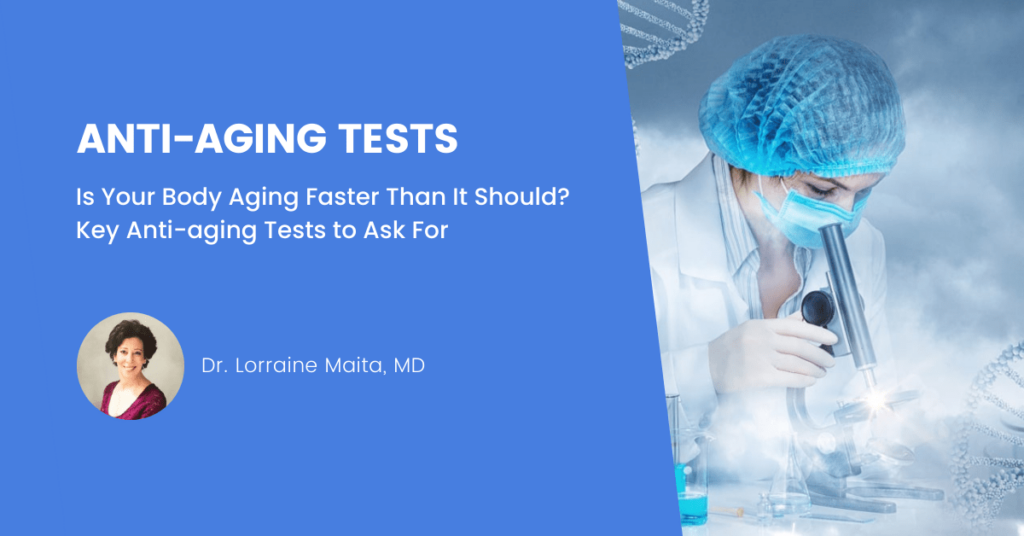- How to Balance Hormones with Supplements, Foods, and Lifestyle - October 26, 2022
- Hormone Imbalance Quiz: Signs, Causes, and Tests you Must Know - September 18, 2022
- The Longevity Lifestyle: Top Anti-aging Strategies to Turn Back the Clock - May 17, 2022
Ever wonder how well are you aging? Is your body aging faster than it should? And if so, is it possible to slow down this process and even reverse it?
In this interview, we spoke with Dr. Lorraine Maita, MD, who specializes in anti-aging medicine about some of the main strategies she uses in her practice. We talked about key anti-aging tests, what they mean, and how they can help guide you towards changing your lifestyle to improve your health and increase your longevity.
My view of anti-aging
You don’t have to age like your parents, grandparents, or siblings. People often think that getting older means losing mobility, vision, hearing, and your senses. They accept that eventually, they will have a serious illness that will land them in the hospital and drain them of their health and finances. They believe that their genes determine their destiny.
I think there’s another way. I believe we can age with more vitality and energy. We can remain active with sound mind, body, and excellent health.
Just like a classic car. If you maintain it properly, you’re going to get a lot more mileage out of it. In fact, it is so fun to drive. A true classic!
The same thing is true for your body. You are not at the fate of your genes. When you maintain your body properly, you can turn bad genes off and turn good genes on. As we learn more about this area of study, called epigenetics, we now know that our genes are affected by our lifestyle and environment. This means that your genes are not necessarily going to run your life, they are not your destiny. You can think of them instead as light switches. They do not act on their own. You can turn them on or off with your habits and lifestyle choices.
In other words, your everyday choices matter! These choices are going to affect the way you age.
Anti-aging tests: The map to longevity and wellness
As we all know, not everyone ages at the same pace. What is perhaps less known, is that different parts in your body also age at different speeds. You may find for example, that your skin ages much faster than your heart, brain, or liver.
I find that this is where certain tests can be very helpful since they often offer insights that can point us towards individual imbalances and risk factors. We can then target these issues with lifestyle modifications and other tools, and retest to measure the progress.
This personalized approach to anti-aging is very powerful, as many of these markers we test for are linked to increased risk for age-related disease and low quality of life. So, addressing these is one of the best measures we can take to prevent, slow, and even reverse some of the aging process.
Popular anti-aging tests and what do they mean
The anti-aging testing strategy can vary greatly depending on a person’s symptoms, health concerns and goals. The idea is not to run every test under the sun but to focus on the most relevant ones that can help find the root causes and provide insights on the progress made. Once we are using testing to understand the root causes, we can tailor the treatment to the individual. Otherwise, we are left just taking tons of supplements and hormones, or simply making changes that don’t have much of an impact.
With that said, here are some of the basic anti-aging tests we usually start from, and what they mean.
1 – Physical fitness, more than just strength and aerobic capacity
Tests such as the YMCA fitness assessment can identify important physical imbalances that are associated with aging, such as loss of muscle strength and impaired mobility. Fitness tests are highly actionable as they investigate various parameters of fitness. With these tests you can assess the strength of each muscle group, your aerobic capacity, balance, and flexibility. Once you have the results you can then address each specific area of weakness in your exercise routine.
It is very important to cover all aspects of physical fitness, not just strength training or aerobic. You also want to consider balance and flexibility as they can help prevent the risk for falls which increases with age.
2 – Bone density and body composition
A DEXA scan is a bone density scan that assesses your risk for conditions such as osteoporosis or osteopenia and evaluate your risk of fractures.
In fact, around a third of people over 65 falls at least once a year. Whether fractures occur greatly depends on bone strength[1]. Testing your bone density early so you can take the right measures to protect your bones can save you a painful hip fracture in 10 or 20 years.
The DEXA scan also provides a precise look into your body composition, an important marker of aging:
- Muscle to fat ratio. Your weight may be the same as 20 years ago, but you could gradually lose a significant amount of muscle, while gaining a significant amount of body fat. These common aging changes can affect more than the way you look and feel; they may increase your risk for age-related conditions, even if you are not overweight.
- Muscle and fat distribution. This information can help identify muscle imbalances that can be targeted in your exercise routine. The scan also shows the visceral fat accumulation around your organs, which may indicate a potential metabolic health issue[2].
3 – Glycation and blood sugar levels
Glycation occurs when sugar binds to various types of proteins or lipids, making them sticky and brittle. You can think of glycation just like the crust you get when you fry a ham with honey. When you eat high glycemic foods such as processed carbs and sugars, a similar reaction occurs inside your body.
Your cells literally become crusty from the inside. The cells then can no longer function properly, and there’s also an increase in oxidation and inflammation.
In fact, glycation is one of the known aging mechanisms that has shown to affect multiple organs and has been linked to numerous age-related degenerative diseases[3]
Hemoglobin A1C (HbA1C) is a test that measures your average blood sugar levels over the past 3 months. While this test is usually used to diagnose prediabetes or diabetes[4], it can also give a good indication of the amount of sugar that can be glycated.
This test is highly actionable. If your hemoglobin A1C score is not optimal, it is important to limit high glycemic foods that can cause high blood sugar levels. Choosing low glycemic foods instead can help control the glycation, inflammation, and oxidation.
4 – Inflammation
Often referred to as “Inflamm-ageing”, systemic inflammation is a known risk factor for accelerated aging, morbidity, disability, frailty, and a shorter lifespan[5]. In fact, the data also suggests that inflammation may be the root cause of many chronic and degenerative diseases.
The C-reactive protein (CRP) test measures the level of c-reactive protein in the blood. A high CRP is a marker of high inflammation. When CRP is high this may be a clue of an underlying illness or an indication of lifestyle factors that are causing excessive inflammation in your body.
5 – Oxidative stress
I like to explain oxidative stress as rust. Just like rust deteriorates metal, oxidative stress damages our cells. Wrinkles are a sign of oxidation which may indicate oxidative stress occurring on the outside. The same thing happens on the inside to our cells.
Oxidative stress is associated with several age-related conditions such as cardiovascular disease, neurodegenerative diseases, sarcopenia and frailty in the elderly[6].
8-hydroxy deoxyguanosine (8-OHdG) is a very well-studied biomarker that measures oxidative stress, DNA damage and can also indicate of risk for certain diseases[7].
6 – Hormone imbalances
With a natural decline in many hormones as we age, making sure your hormones are balanced and at optimal levels is extremely important. Hormone imbalances not only reduce your quality of life, they can also increase your risk of age-related disease.
When testing hormones, it is important to always consider and identify the root causes of the imbalances, as they can completely change the course of treatment. You may have an underlying condition or lifestyle factors that play a role. Your diet, stress, sleep, exercise, exposure to certain toxins, and many other factors can significantly affect your hormones.
If you are concerned about your hormones, I highly recommend working with a functional medicine doctor that specializes in hormone therapy to make sure you properly identify and address the root cause of the imbalances.
7 – Telomere age and length
Telomeres are the caps on the ends of our chromosomes that protect against the loss of DNA and genetic information during cell replication. When these ends become too short, the cells can’t replicate, and can no longer be replaced.
Telomere shortening is a well-known hallmark of aging[8] (telomere attrition) and has been shown to affect both health and lifespan, including an increased incidence of age-related diseases[9,10].
8 – Biological age and pace of aging
Unlike your chronological age which simply tells when you were born, your biological age measures how your body ages at a cellular level. Your biological age can be younger, the same, or older than your chronological age.
This is where biological age testing can be handy. You start with an initial baseline by measuring your biological age versus your chronological age including your pace of aging along with other markers and risk factors. You then introduce lifestyle changes and other measures according to your results. At some point, you retest again to see if your biological test has changed.
This is where things get exciting. Very often we can see a dramatic reduction in biological age along with other improvements. This is where you may start to feel like your (younger) self again.
As we mentioned earlier, with the study of epigenetics, we now know that with healthy lifestyle choices we can “turn off” disease-causing genes and activate protective, longevity genes. These changes are reflected in the biological age.
My own anti-aging test results

To give you an idea about some of these tests, here are my own results using the TruAge test. This test combines biological age, telomere length and age, among many other useful markers.
So, how did I do? Here are some of the comparisons of my biological age vs. chronological age:
- Biological age: 9 years younger
- Telomere age: 17 years younger
- Immune age: 10 years younger
- My current pace of aging 0.89
The average person ages at a rate of 1 biological year/1 year of chronological aging. A score below one, means you age slower than the average. This test is very helpful, as it allows you to evaluate how your current lifestyle affects the pace you are aging.
Final Thoughts
Anti-aging tests often offer powerful insights which can help to tailor and optimize the treatment. If you consider doing some of these tests, I highly recommend that you work with a qualified health practitioner who can help order the right tests for you, properly interpret the results, and address any concerns that come up.
Read next: The longevity lifestyle: top anti-aging strategies to turn back the clock.


